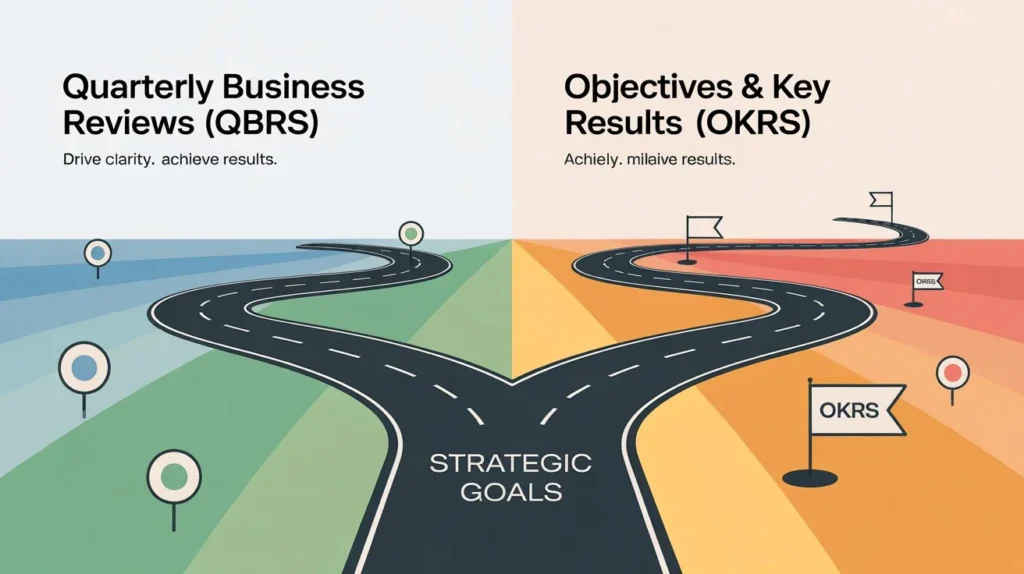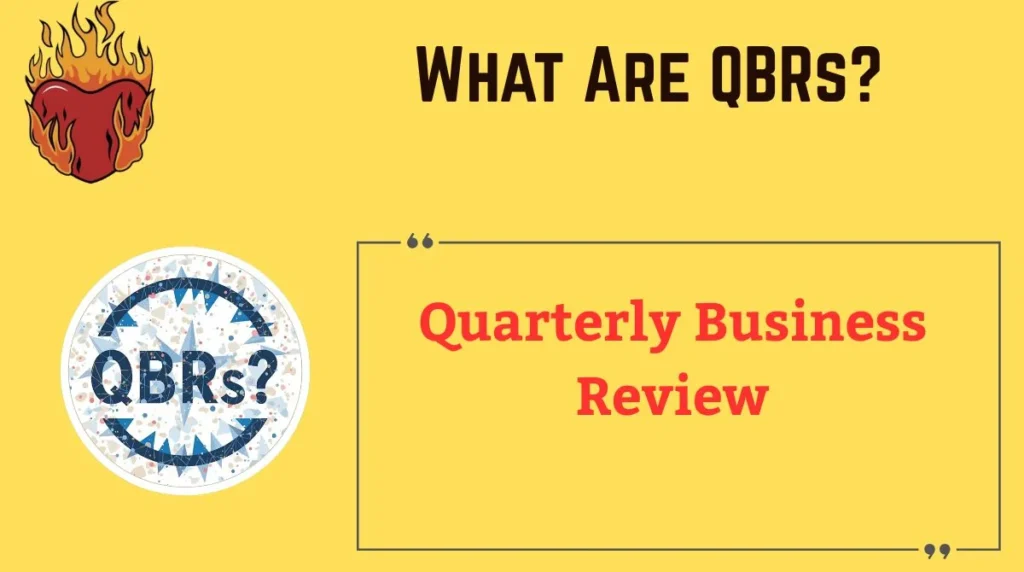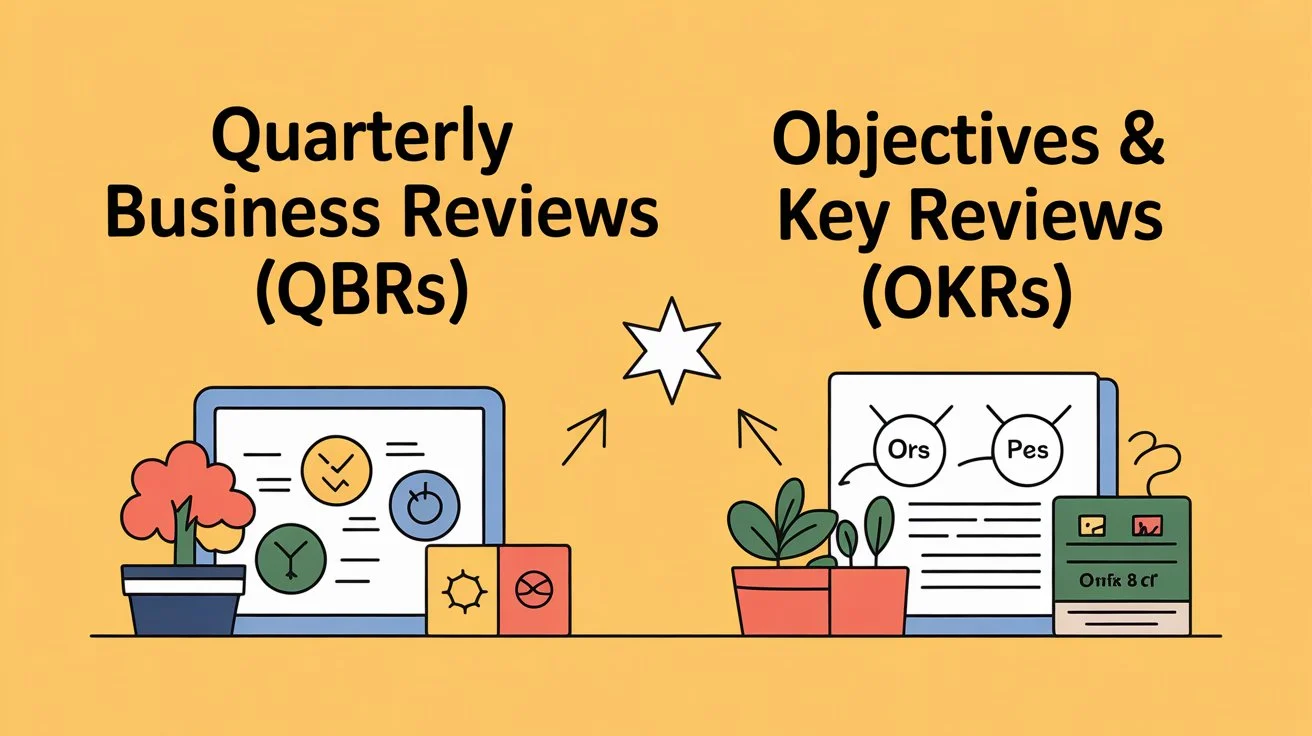Quarterly Business Reviews (QBRs) and Objectives & Key Results (OKRs) have become powerful tools for companies that want sharper focus, stronger alignment, and measurable growth.
Done right, they’re not just meetings or goal-setting frameworks — they’re engines that connect day-to-day work with long-term vision.
This complete guide explains what QBRs and OKRs are, why they matter, and how to implement them together. You’ll find practical tips, real-world examples, and templates you can adapt to your organization.
Why QBRs and OKRs Belong Together

Many companies run quarterly meetings but fail to link them with a clear goal framework. As a result, teams gather data, present slides, and then walk away without actionable insights. QBRs supported by OKRs change that.
When QBRs (Quarterly Business Reviews) and OKRs (Objectives and Key Results) work together, organizations get:
- Clarity: Everyone knows what matters for the next quarter
- Alignment: Teams push in the same direction
- Accountability: Progress is visible and measurable
- Agility: Strategies can shift quickly without losing focus
This guide walks you through the process step by step.
Understanding QBRs

What Are QBRs?
A Quarterly Business Review is a structured meeting held every quarter to review performance, discuss challenges, and plan for the future. While QBRs originated in client-success settings, internal QBRs are now widely used for cross-functional alignment.
External QBRs: Focus on client relationships and service delivery.
Internal QBRs: Focus on company-wide or department-wide goals, metrics, and adjustments.
What Are Internal QBRs?
Internal QBRs are run inside the organization. They’re designed to:
- Evaluate how well teams are meeting strategic objectives
- Share successes and challenges openly
- Realign priorities for the next quarter
Objectives of an Internal QBR
An internal QBR should accomplish three main goals:
- Review progress: Look at how the team performed against planned objectives
- Identify issues: Spot problems early and develop solutions
- Plan forward: Decide on priorities and allocate resources
Roles and Attendees
QBRs fail when the wrong people fill the room. Invite only those who can contribute meaningfully or make decisions.
Key participants include:
| Role | Responsibilities |
|---|---|
| Facilitator (QBR Owner) | Plans and runs the meeting, keeps agenda on track |
| Executive Sponsor | Provides strategic context and approves major changes |
| Team Leads / Managers | Present updates, discuss challenges and wins |
| Analyst / Data Owner | Prepares metrics and dashboards for review |
| Note-Taker | Records decisions, actions, and owners |
Limit the group to 10–15 people for deep discussions without chaos.
Why QBRs Matter
Companies that invest time in structured quarterly reviews outperform those that don’t. Here’s why:
- Strategic connection: QBRs link quarterly execution with annual strategy.
- Cross-functional alignment: Different teams see the bigger picture.
- Data-driven decisions: Meetings focus on facts, not anecdotes.
- Early warning signals: Problems are caught before they snowball.
“A QBR without preparation is like a plane without a flight plan. You might take off, but you won’t land where you expect.” – Anonymous COO
Common Problems That Undermine QBRs
Even well-meaning QBRs can backfire. Avoid these pitfalls:
- Unclear mission and vision: Teams waste time reporting on irrelevant metrics.
- Focusing on outputs instead of outcomes: Counting tasks done rather than results achieved.
- Lack of transparency: Data hidden in silos makes discussions incomplete.
- Skill or resource gaps: Teams can’t deliver on objectives without proper support.
- Insufficient preparation: Meetings turn into status updates instead of strategy sessions.
Preparing for a QBR
Preparation determines whether a QBR is productive or painful.
Key steps:
- Define strategic goals: Translate annual objectives into quarterly targets.
- Appoint a QBR owner: This person ensures consistency and accountability.
- Invite the right participants: Include decision-makers and subject-matter experts.
- Gather data early: Pull metrics, dashboards, and customer feedback at least one week in advance.
- Draft an agenda: Align discussion points with desired outcomes.
The Ideal QBR Agenda
A clear agenda keeps everyone focused. Below is a sample QBR agenda with time allocations:
| Agenda Item | Purpose | Time Allocation |
|---|---|---|
| Welcome and Context | Set tone, review objectives | 5 minutes |
| Strategic Overview | Where we’re heading | 10 minutes |
| Performance Review | Metrics vs. goals | 20 minutes |
| Success Stories & Challenges | Celebrate wins, identify roadblocks | 20 minutes |
| Realignment | Adjust priorities and resources | 15 minutes |
| Strategic Planning for Next Quarter | Define next steps | 20 minutes |
| Open Discussion & Q&A | Encourage cross-team input | 15 minutes |
| Closing, Commitments, Next Steps | Summarize and assign action items | 5 minutes |
This structure ensures no topic overwhelms the meeting and decisions are captured.
Avoiding Common QBR Pitfalls
Here’s a quick checklist:
- Don’t overload the agenda with raw data — focus on insights.
- Always connect discussions to strategic goals.
- Avoid turning QBRs into a blame game.
- Assign owners to each action item before leaving the room.
- Share a follow-up summary within 48 hours.
OKRs – The Engine Behind Effective QBRs
What Are OKRs?
Objectives and Key Results (OKRs) are a goal-setting framework used by companies like Google, Intel, and LinkedIn. They consist of:
- Objectives: Qualitative, ambitious goals that inspire and direct effort.
- Key Results: Quantitative measures that track progress toward the objective.
Example:
| Objective | Key Results |
|---|---|
| Improve customer retention | 1) Increase NPS from 45 to 60 2) Reduce churn from 8% to 5% 3) Launch loyalty program by Q3 |
How OKRs Transform QBRs
QBRs supported by OKRs shift focus from reporting to strategic conversation. Instead of endless updates, teams discuss how well they’re progressing on clear, measurable outcomes.
Using OKRs to Power Up QBRs
Integrating OKRs with QBRs brings several benefits:
- Save time with structured objectives: Everyone knows the priorities before the meeting.
- Measurable Key Results: Quantitative goals anchor discussions.
- Clear Objectives: No ambiguity about what matters most.
- Prioritization: Only critical issues make it onto the agenda.
- Continuous Monitoring: Dashboards track progress between QBRs, so meetings are about decisions, not data collection.
- Transparency: Everyone sees the same information at the same time.
Tip: Use a standard OKR template in all departments to streamline reporting.
Tools and Software for Managing QBRs with OKRs
Choosing the right platform can reduce admin work dramatically. Look for:
- Integrated dashboards (real-time performance data)
- Cross-team visibility (no silos)
- Automated reminders (so deadlines aren’t missed)
- Exportable reports (for executives or investors)
Examples of platforms:
| Platform | Best For | Notable Features |
|---|---|---|
| WorkBoard | Large enterprises | Strategy mapping, OKR scoring |
| Weekdone | SMEs | Team-level OKRs, status updates |
| Perdoo | Mid-sized companies | Strategy tree, KPI tracking |
| Ally.io | Fast-scaling teams | Microsoft integration, insights |
Integrating QBRs and OKRs into Your Culture
To make QBRs and OKRs stick, treat them as part of your organization’s rhythm rather than one-off exercises.
Best practices:
- Establish a predictable quarterly cadence.
- Encourage every team to create and own their OKRs.
- Use QBRs to review progress and adjust strategy — not just to report status.
- Celebrate wins publicly to reinforce accountability.
- Keep learning: after each QBR, ask what went well and what to improve next time.
“Culture eats strategy for breakfast — but strategy powered by QBRs and OKRs changes the menu.” – Leadership Coach
Frequently Asked Questions
How long should a QBR last?
For internal teams, 90 minutes to two hours is usually enough. External QBRs with key customers may take longer, but keep sessions focused.
How often should OKRs be reviewed?
Review OKRs monthly, not just quarterly. This keeps everyone aligned and avoids surprises at the QBR.
What’s the biggest mistake companies make with QBRs?
They treat QBRs as status-update meetings. The focus should be on insights, alignment, and decisions.
Can small businesses use QBRs and OKRs?
Absolutely. Even a five-person startup benefits from quarterly alignment and measurable goals.
Should OKRs replace KPIs?
No. KPIs track ongoing performance. OKRs drive change and improvement. Use them together.
Conclusion
When QBRs and OKRs work hand in hand, they turn quarterly meetings from routine check-ins into strategic powerhouses. Teams know where they’re going, progress is measurable, and adjustments happen before small issues become big ones.
Start by defining clear objectives, adopting a simple OKR framework, and structuring your QBRs around decisions rather than updates. Over time, this rhythm will create a culture of transparency, accountability, and high performance.

Mark Peter is the creative mind behind RizzleLineLove.com, your go-to hub for witty, flirty, and downright hilarious pick-up lines. With a passion for blending humor and charm, Mark crafts content that sparks conversations, breaks the ice, and adds a playful twist to everyday moments.
Whether you’re looking to impress your crush, make your friends laugh, or spice up your social media captions, his work is all about helping you connect — one clever line at a time.



